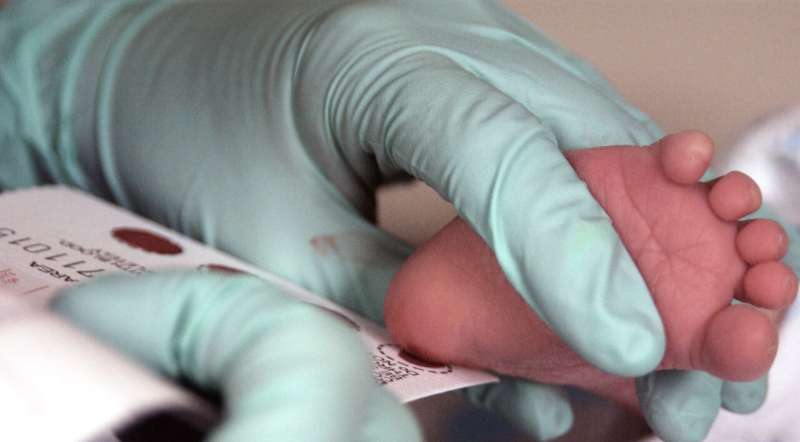This article has been reviewed according to Science X's editorial process and policies. Editors have highlighted the following attributes while ensuring the content's credibility:
fact-checked
peer-reviewed publication
trusted source
proofread
Screening newborns for deadly immune disease SCID saves lives

Introducing widespread screening of newborns for a deadly disease called severe combined immunodeficiency, or SCID, followed by early treatment boosted the five-year survival rate of children with the disorder from 73% before the advent of screening to 87% since, researchers report. Among children whose disease was suspected because of newborn screening rather than illness or family history, 92.5% survived five years or more after treatment. These findings demonstrate for the first time that newborn screening facilitated the early identification of infants with SCID, leading to prompt treatment before life-threatening infections occurred and thereby increasing the proportion of children who survived to age 5 or beyond. Researchers at the National Institute of Allergy and Infectious Diseases (NIAID), part of the National Institutes of Health, and colleagues led the retrospective study, which The Lancet published today.
"This study definitively shows that population-wide newborn screening for SCID has made it possible to save the lives of many more children with the disorder than ever before," said NIAID Acting Director Hugh Auchincloss, M.D. "We hope these findings will encourage more countries to screen newborns for this devastating disease."
SCID is a rare disorder caused by mutations in genes involved in the development and function of infection-fighting immune cells. Infants with SCID appear healthy at birth but are highly susceptible to severe infections. The condition is fatal, usually within the first year or two of life, unless the infant receives an immune-restoring treatment such as a stem-cell transplant, gene therapy or enzyme therapy. Forty to 80 babies in the United States and Canada are diagnosed with SCID annually. The number of babies born with the disorder globally is unknown because most countries do not yet screen for SCID. Incidence ranges from 1 infant per 2,000 live births in regions where inbreeding is common to 1 per 60,000 live births where it is not.
NIH scientists developed a newborn screening test for SCID in 2005. The test's gradual adoption has made it possible to detect the disease in infants before symptoms appear, take steps to prevent infection, and provide life-saving treatment early. Individual U.S. states and Canadian provinces began screening newborns for SCID in 2008, starting with a pilot program in Wisconsin. By the end of 2018, all U.S. states, Washington, D.C., and two U.S. territories were performing newborn screening for the disorder. Seven Canadian provinces and territories currently do so.
Several studies previously suggested that population-wide newborn screening for SCID improved survival, but none proved it. For this reason, the NIH-funded Primary Immune Deficiency Treatment Consortium (PIDTC) set out to definitively measure whether the advent of population-wide newborn screening for SCID had improved the overall survival of infants with the disease. The PIDTC is part of NCATS' Rare Diseases Clinical Research Network and consists of 47 centers in North America with the shared goal of improving health outcomes of people with rare, life threatening, inherited disorders of the immune system.
PIDTC investigators analyzed data on more than 900 children with confirmed SCID who received treatment for the condition with a transplant of blood-forming stem cells from a non-genetically matched donor at one of 34 sites in the United States or Canada between 1982 and 2018. The researchers examined the five-year overall survival rate of these children from 2010–2018, when state- and province-wide newborn screening was in effect at participating sites, compared to earlier time periods. The researchers excluded infants who received stem-cell transplants from genetically matched sibling donors from the analysis, because these children had high overall survival rates throughout the study period.
The five-year overall survival rate for children with SCID who received a stem-cell transplant from a non-genetically matched donor remained steady at 72% to 73% from 1982 to 2009 despite advances in clinical care, then increased to 87% during the years 2010 to 2018. Among children whose disease was first suspected based on the result of newborn screening rather than on illness or family history of SCID, and who received a transplant between 2010 and 2018, 92.5% survived to age 5 or beyond.
Previous research had shown that being younger than 3.5 months at the time of transplant and not having an active infection at that time improved five-year survival rates for children with SCID. An analysis of the PIDTC data demonstrated that both these factors were much more common in the era of newborn screening and drove the increase in the proportion of children who survived to age 5. In addition, in 2010–2018 compared to previous decades, the percentage of babies with SCID who had never had an infection by the time of transplant was dramatically higher, further fueling the survival increase. Moreover, regardless of the transplant technique used, the percentage of children who survived to age 5 was highest in 2010–2018 compared to earlier decades.
More information: Measuring the effect of newborn screening on survival after haematopoietic cell transplantation for severe combined immunodeficiency: a 36-year longitudinal study from the Primary Immune Deficiency Treatment Consortium, The Lancet (2023). DOI: 10.1016/S0140-6736(23)00731-6














